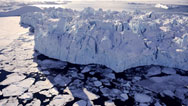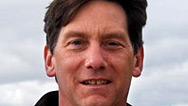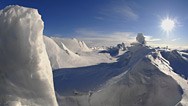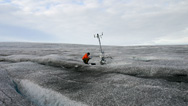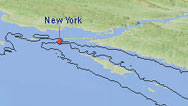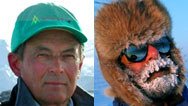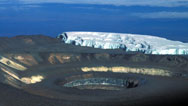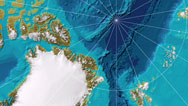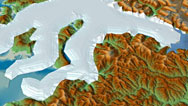
Extreme Ice
An acclaimed photographer teams up with scientists to document the runaway melting of arctic glaciers. Airing December 18, 2013 at 9 pm on PBS Aired December 18, 2013 on PBS
- Originally aired 03.24.09
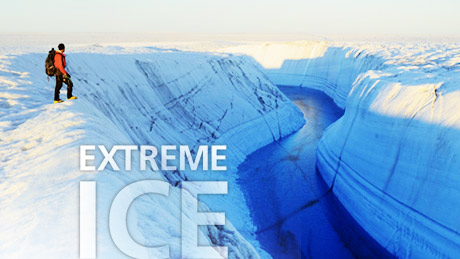
Program Description
Transcript
Extreme Ice
PBS Airdate: March 24, 2009
NARRATOR: In the extreme, ice-bound regions of the earth, something unprecedented is happening. Everywhere, glaciers and ice sheets have begun breaking apart and accelerating toward the oceans faster than ever imagined possible.
DR. JAMES WHITE (University of Colorado at Boulder): Can we put the brakes on it at any point? Do we have that much control?
DR. MARK SERREZE (National Snow and Ice Data Center): There are concerns that we get to some point that the changes become pretty much unstoppable.
NARRATOR: Over the history of the earth, ice has frequently advanced and receded, but now it's changing in ways we don't fully understand. With the future of the ice in question, photographer James Balog risks everything to capture what's happening, on film.
JAMES BALOG (Extreme Ice Survey): This is one of the scariest, dumbest things I've done in my life. Where I'm laying right now was under water just six hours ago. I'm not feeling real comfortable out here.
NARRATOR: His incredible imagery is witness to one of the earth's most powerful geological forces, a force that, for the first time in modern human history, is radically changing the planet. Extreme Ice revealed, right now on this NOVA/National Geographic Special.
NARRATOR: James Balog has a near-fatal attraction to ice.
JAMES BALOG: Oh, god, that is intense.
NARRATOR: His fascination is leading him farther and deeper into the cryosphere, the frozen regions of the earth.
JAMES BALOG: I feel like I'm not on Planet Earth right now, like I am in truly some extraterrestrial environment. The world isn't supposed to look like this.
NARRATOR: What began as a photographic assignment has become a mind-blowing odyssey into an unpredictable world, where entire landscapes teeter between solid and liquid states.
On the Greenland ice sheet, a crack opens and a mile-wide lake pours down a 3,000-foot chasm.
JAMES BALOG: This water is just drilling down into the ice sheet.
NARRATOR: One of the world's biggest glaciers shears off an iceberg that is nearly a thousand feet thick.
JAMES BALOG: You're not supposed to be able to witness things like this. Human beings don't generally get to see these massive features of the landscape changing and vanishing in front of your eyes.
NARRATOR: Changes in the ice are normal. It is volatile and constantly in flux, but what Balog is witnessing suggests something extraordinary is going on. His passion is to document it and help scientists understand these monumental changes.
MARK SERREZE: Many of the changes we're seeing are unfolding faster than our ability to really understand them.
JAMES WHITE: Our relationship with ice is one that has very dramatically, if not violently, shifted from one of, ah, "Don't worry about it," to one of, "Boy, you know, this is one of the most important controllers of the future environment of the planet."
NARRATOR: Balog's work frames one of the most important scientific questions humans have ever faced: how fast will the world's glaciers and ice sheets melt, and what will all that melting mean for us?
As scientists try to figure it out, Balog is finding evidence to help answer some of these questions.
JAMES BALOG: Got it.
NARRATOR: His Extreme Ice Survey is the largest photographic study of the cryosphere ever attempted. He is deploying 26 time-lapse cameras on glaciers across the northern hemisphere and programming them to shoot a frame every daylight hour for three years. It is a massive challenge, in some of the most hostile regions on Earth.
JAMES BALOG: So everything we're trying is getting thwarted. I'm trying not to be frustrated.
NARRATOR: But the pain is starting to pay off, with thousands of frames revealing unparalleled changes in the ice.
JAMES BALOG: My hope is that it will be powerful and immediate enough that people will say, "Yeah, I get it, I understand it. Okay, this is real. This is forensic evidence of the reality of what's happening."
NARRATOR: The fact that the ice is changing is nothing new. Over the millennia, the expansion and contraction of ice across the continents has fundamentally altered the planet, gouging out lakes and valleys and pushing man around the earth.
DR. RICHARD ALLEY (The Pennsylvania State University): The waxing and waning of the ice sheets have been implicated in who lives where and what they do. And there are even some people who have suggested that we're humans now, in part, because we were responding to the changes in our environment that were linked to the growth and shrinkage of the ice.
NARRATOR: In the past, the cycle of ice ages and periods of warming were caused mainly by shifts in the earth's orbit around the sun, but now, humans seem to be driving these changes. Since the Industrial Revolution, our burning of fossil fuels has ratcheted up the output of greenhouse gases like carbon dioxide, which trap heat in the atmosphere. Temperatures are climbing, and the ice is melting faster than ever.
JAMES WHITE: I think that if we stay on the path we're on, we will change the amount of land ice and therefore we will change sea level. The real questions, the more complicated ones: how fast are we going to get there? How much is it going to rise? Can we put the brakes on it at any point?
NARRATOR: It is the speed of the melt that is most astonishing, and nowhere is it happening faster than in the glaciers along the west coast of Alaska.
Glaciers are like massive ice factories. High in the mountains, snowfall builds up and is compacted over hundreds of years. Gravity pulls it down in colossal rivers of ice.
Some glaciers flow all the way to the ocean, shearing off icebergs, in a process called calving.
Over the last 40 years, temperatures here in Alaska have risen about four degrees Fahrenheit, twice as fast as the global average. Now these rivers of ice are flowing faster and crashing even more spectacularly into the sea.
Some people are taking advantage of the glacial fireworks while they last. Surfers towed in by jet skis are playing a dangerous game of chicken with the ice.
It is rapidly-calving glaciers, like these, that are the main contributors to rising sea levels.
Alaska's Columbia is one of the biggest ocean-feeding glaciers in North America.
In the early 1980s, the Columbia started flowing faster and began calving far more ice into the ocean than was being replenished by snowfall upstream. Balog and the Extreme Ice Survey glaciologists are trying to figure out how much ice the Columbia is losing and whether or not it can survive.
NARRATOR: In the shallow waters of Columbia Bay, melting icebergs jam up before being carried away with the tide. This is the end of the line for the Columbia, a crystal maze of deteriorating ice that draws Balog in.
JAMES BALOG: Out here, basically, we're looking at a whole landscape full of crystals.
It's a cool spot. There's a lot of power here. It seems to be calm, it seems to be still, but there's this constant energy of the sea coming and going and carrying this huge glacier away.
Every time you go in here you're taking a risk, because these bergs are inherently unstable. But you get seduced by the beauty of it, you know? You just get drawn in. It's like the sirens of Columbia Bay pulling you in, luring you in, going, "Come to me, come to me, come to me." And you just keep following these beautiful objects back through the labyrinth.
Okay, Jeff, right about on this line, here.
The light that really makes these sculptures come alive is bouncing off the surface of the water, so the bergs are lit from within. Oh!
NARRATOR: At the Extreme Ice Survey camp, glaciologist Tad Pfeffer tracks the flow of the Columbia. As the glacier moves, it churns up dirt and rocks that collect on its surface. The Columbia is so vast, it's hard to imagine it vanishing.
Pfeffer and his colleague, Shad O'Neel, are taking its vital signs, measuring the speed of the glacier over several years to determine whether it's speeding up or slowing down. To do this, they fire a laser survey gun at reflective targets that they must deploy on the surface of the ice.
As the pilot hovers a few inches above the glacier, O'Neel positions the target onto the ice.
Pfeffer locks onto the target and shoots a laser that reflects back to the stationary gun, recording the position.
DR. TAD PFEFFER (University of Colorado at Boulder): I got it. You're good. Come on back.
Okay, first one down, 1.1 kilometers away.
NARRATOR: The target moves with the ice. By tracking its movement with the laser, over several days, they will be able to calculate the speed of the Columbia.
Just down the fjord, Balog and Extreme Ice Survey engineer, Adam LeWinter, climb down to one of the time-lapse cameras they installed a year ago.
JAMES BALOG: Oh, yes, here it is, here it is.
ADAM LEWINTER (Extreme Ice Survey): Still all there?
JAMES BALOG: Yeah, the camera's here, but what happened to the glacier? When I was here a year ago, that calving face was just right there.
All right, we have pictures.
NARRATOR: The time-lapse brings to life the dynamic nature of the glacier, the ebb and flow of the ice as it calves.
JAMES BALOG: It's a revelation. Every time we open up these boxes and download these images and bring them up on the computer and play them back, your eyes are popping out of your head.
NARRATOR: Although calving is normal, the Columbia is hemorrhaging ice so quickly that in the last 30 years the glacier has receded 10 miles up the fjord.
Balog's time-lapse images capture a rate of retreat that shows no sign of stopping. In the last year alone, the Columbia lost another half-mile of ice.
JAMES BALOG: I really never expected that we were going to see changes of anything like this kind of magnitude in the period of time we had to work on this.
NARRATOR: This rapid calving of the Columbia is a symptom of its decline, but it's poorly understood. If Pfeffer and O'Neel can figure out what's causing it to calve more ice, it may help them predict the glacier's future.
They're taking a curious tack by using earthquake technology to crack open the mystery of the ice.
They're installing seismometers that pick up the vibrations of icequakes, tremors that reverberate through the ice as it calves. From the seismic data, a pattern emerges that points to one clear culprit, water.
They knew water was melting the ice, but it appears that it's prying the ice apart, like a powerful lever.
DR. SHAD O'NEEL (U.S. Geological Survey Alaska Science Center): You can hear meltwater running right now, and it's all getting stuck in the glacier. And if you have a fracture with high-pressure water in it, it can ratchet the crack open.
NARRATOR: The seismic record confirms that the calving events have the unique signatures of fractures caused by water. As rising temperatures create more surface melt, the water pours into the cracks in the glacier and wedges it apart.
The result is increased calving and a quicker demise of the glacier.
JAMES BALOG: Oh there's a big one coming up from underneath. There it is.
NARRATOR: Balog is seeing this powerful fracturing effect firsthand, as the fjord below comes alive.
JAMES BALOG: That basal ice has come up from the very bottom of the glacier, that dark blue, out there. As the ice and the snow are squeezed together, the air gets driven out of it, and so the color becomes more and more pure—the air bubbles are what make it white. And so when the base of the glacier breaks up, you get these fantastic sapphires and turquoises boiling up out of nowhere, you know, and that's what these bergs are.
NARRATOR: Meanwhile, after several days of laser tracking, Tad Pfeffer knows how fast the Columbia is moving: 50 feet per day—eight times faster than it was 30 years ago.
TAD PFEFFER: Go back to 1980: here, on this bedrock, we had ice above us, 1,500 feet. Look at the trimline over there. That's where the ice surface was in 1980. And all of that volume is lost, because this calving is so fast and snowfall upstream isn't re-supplying it. So, in that sense, yeah, it's going too fast, and the glacier is kind of collapsing.
NARRATOR: Pfeffer suspects that the Columbia is long past its tipping point, and it's only a matter of time before it withers away, entirely.
JAMES BALOG: This kind of ice is called dead ice. It's no longer part of the living, active glacier. It's stranded up on the side of the ice stream, and it's melting away and collapsing. And as it does that, all the erosional debris that's on the top continues to concentrate, until you have this ice, covered in blackness.
I'm really interested in the mortality of the glacier right here. There's something very rich and very intense about the changing landscape, you know? I feel the end; I feel the death right here.
NARRATOR: The problem is it's not just the Columbia that's on its way out. Glaciers everywhere, across the Rockies, Andes, Alps and Himalayas, are in their death throes.
RICHARD ALLEY: The people that live near the mountains and watch the glaciers know that the world is changing. We are heading towards Glacier National Park without any glaciers. We're seeing huge changes in Glacier Bay in Alaska, and other places. If you go, if you look, you see it.
NARRATOR: The consensus is that in the next 50 to 100 years, mountain glaciers almost everywhere will simply disappear. From the loss of mountain glaciers alone, sea levels will rise by almost a foot, displacing millions of people around the world. But the biggest cost will be the loss of these huge natural reservoirs of fresh water, water that one-sixth of the world's population depends on.
The hardest hit will be in Asia, where nearly a billion people get their drinking water from Himalayan glaciers.
The abrupt collapse of the world's mountain glaciers raises even more disturbing questions about the earth's biggest tracts of ice, the polar ice sheets of Antarctica and Greenland.
MARK SERREZE: The real wildcards are what the big ice sheets are going to do. We're already seeing the Greenland ice sheet start to behave in rather disturbing ways.
JAMES WHITE: We're playing with fire, if you will, when it comes to the ice sheets. We don't know whether, if we get these big, massive, freight-train-like beasts going, whether we can stop them.
NARRATOR: The potential for the polar ice sheets to flood the planet is staggering. If all of Greenland and Antarctica were to melt, the oceans would rise 200 feet, but, over geologic time, these ancient bulwarks of ice have withstood many bouts with climate warming.
Until a few years ago, scientists thought the ice sheets were simply too big and too dense to be an immediate risk, but the latest evidence is making them rethink.
The first wakeup call came from the West Antarctic Peninsula. In the summer of 2002, a NASA satellite photographed a Rhode-Island-sized slab of ice, called Larsen B, as it sheared off the ice shelf. Other collapses followed, turning the assumption that it would take thousands of years for the big ice sheets to melt on its head.
RICHARD ALLEY: The ice sheets surprised us. We sort of thought that the little glaciers would melt when it got warmer and that the big ice sheets wouldn't do much. And, all of a sudden, the big ice sheets started rumbling faster, and the Larsen B was falling apart. And we said, "Whoa, that wasn't supposed to happen."
NARRATOR: On the other side of the globe, Greenland's cache of ice is also showing signs that it's starting to feel the heat. In the last decade, temperatures here have shot up by about five degrees Fahrenheit. NASA satellites are already detecting a meltdown around the edges of the ice sheet. Global warming is hitting hardest in the Arctic, and all eyes are now fixed on Greenland's ice. Its next move could be the game changer for rising sea levels.
In the heart of Greenland, Balog and scientists encounter an entirely different realm: a single slab of ice about 1,500 miles long and 500 miles wide. It's mid-July, and the summer melt on the Greenland ice sheet is in full swing.
JAMES BALOG: It's sort of like an ice version of Kansas out here. It feels like you're out in the Great Plains, and it just happens to be white, and there's this vast dome of ice in the sky overhead.
It's, it's unbelievable. There's no sound at all, no sound, except the wind and the water. It looks quite featureless when you just look horizontally, but as you walk over it and you look down on it, there's a tremendous amount of texture and detail in here. This entire surface is like one gigantic Swiss cheese.
NARRATOR: During the melt season, the sun's heat transforms the surface of the ice, creating a landscape that constantly shifts between solid, liquid and vapor. The meltwater courses through the ice sheet, searching for a path down.
Figuring out how this complex plumbing works is essential for predicting the future of the ice sheet.
JAMES BALOG: Oh man! Look at that. Whoa. That is intense. Oh, my god.
I can see, I think, maybe 250 feet down into the dark, no sign of the bottom, but this water is just drilling down into the ice sheet.
There's this great unknown here, this great mystery of, "Where does all this water go, and what does it do to the flowing and the melting of the ice sheet in sending it out to sea?" Nobody really knows.
NARRATOR: Balog wants to get a shot that delves deep into the underbelly of the ice.
The only way to secure his ropes is to thread them through the ice sheet.
JAMES BALOG: You know, this ice sheet is cooking down and melting a lot, so this whole top foot and a half, where you would normally put an ice screw, is rotten and loose, whereas, here, we are actually using the ice sheet itself and the strength of the ice to anchor the ropes.
So, here we go.
MAN: ...a little slack.
JAMES BALOG: Okay, yeah, how about that?
NARRATOR: These giant holes, called moulins, are thought to bore thousands of feet through the ice to the bedrock, but nobody has ever been down there to find out.
JAMES BALOG: Oh, god, that's the first time I've really seen the hole down there.
This whole balcony could go any second. There it goes!
It's a strange, evil, gorgeous, horrible, fantastic place.
Wow. I mean, there's hundreds of years of ice here, layered in, and we're looking into the cross-section of this life history of the glacier. And it's so beautiful, this insane aquamarine and all this scalloping and fluting from the water, what a spot!
NARRATOR: Balog is just scratching below the surface of the ice sheet. Below him is another half-mile of solid ice. In these compressed layers of the ice sheet, there are clues to how fast Greenland could melt.
NARRATOR: At the National Ice Core Lab, in Lakewood, Colorado, a giant freezer stores over 45,000 feet of ice, drilled from 34 sites around the cryosphere. Dating back hundreds of thousands of years, these ice cores are time capsules that allow scientists, like Jim White, to peer deep into the history of ice.
JAMES WHITE: This piece of ice is interesting, 'cause it has a couple of things you can see, right away. One is there are bubbles throughout here. These bubbles are little packets of air. It's these bubbles we can take out and measure CO2 and methane and nitrous oxide. It's the only medium that really collects the atmosphere itself.
The other thing you can see in here, quite clearly, is you can see the layers, and the thickness is going to tell you how much snow fell that year, so you get a couple of pieces of climate information and a dating scale, just out of visually looking at this ice core.
NARRATOR: Most importantly, scientists have identified a direct historical link between increases in greenhouse gases, like carbon dioxide, and steep rises in global temperatures.
At every peak, big rises in sea level followed as Greenland's ice sheet shrank.
The ice core records also reveal a particularly telling moment in Greenland's history. Roughly 125,000 years ago, temperatures rose by about seven degrees Fahrenheit; the entire southern portion of the ice sheet melted, and global sea levels rose by over 10 feet.
It was caused by a change in the earth's orbit around the sun, which increased temperatures and released carbon dioxide from the oceans.
The more recent ice core record shows the potential for a similar meltdown. Right now, greenhouse gas levels in the atmosphere are even higher than they were 125,000 years ago, higher than they've ever been in the last half-million years. Temperatures are already following suit.
The only explanation is the burning of fossil fuels.
JAMES WHITE: What we see in this ice core is very solid evidence that what's happening today in the atmosphere is different. It's not a normal part of the climate cycle. It's something caused by human beings.
NARRATOR: Rising temperatures are once again pushing Greenland towards a major meltdown, but what the ice cores can't tell us is how long it will take. The last time Greenland lost a significant portion of its ice, White suspects, it happened over thousands of years. But this time, it could happen much faster.
MARK SERREZE: And here we are, now, fiddling with the dials of the climate machine, not quite knowing what's going to happen. And we know from these past records that the climate system can come up and bite us hard.
NARRATOR: So far, global warming is biting hardest at the fringes of Greenland's ice sheet. Ringing the island are hundreds of outlet glaciers that act like pipes, draining the interior ice sheet out to sea through narrow fjords. In the late 1990s, many of these spigots began gushing more ice.
One of the largest, Jakobshavn, is now pumping out over 40 billion tons of icebergs each year, more than any other glacier in the northern hemisphere.
These icebergs reach the open ocean at Disko Bay.
In this deceptively peaceful icescape, James Balog is on the hunt for giant bergs.
Some of these blocks of ice rise over 300 feet above the waterline, but 90 percent of their mass is hidden below.
JAMES BALOG: Oh, my god, these things are gigantic. If they roll over, we'll be swimming with the fishes.
Right in here, there's this line of jewels as you come around the arc of this berg, and all the water drops are coming in, and the sun makes this fantastic necklace of jewelry along the edge of this.
Ah, man, let's do it again. There's something in there.
It's making me crazy, actually, 'cause this...there's a picture in here, there's definitely a picture in here.
Wow, that was amazing!
NARRATOR: Thirty-five miles up the fjord from Disko Bay,
Balog's time-lapse cameras are stationed above the calving face to capture
Jakobshavn's every move.
Balog has teamed up with glaciologist Jason Box, who has been keeping a close
watch on Jakobshavn and other glaciers along the coast, for the past 14 years.
DR. JASON BOX (The Ohio State University): The Jakobshavn glacier is the king of glaciers in Greenland. It produces, by far, more icebergs and more ice flow than any other single glacier. This is really where the rubber hits the road in terms of sea level rise.
Glaciers are, of course, very dynamic systems, but you don't really see that when you sit there and stare at them. We're able to observe with the time-lapse cameras at a much higher frequency, like every hour, whereas from satellite you can only observe the glacier every 10 days or so.
NARRATOR: What they are finding is that the ice is far more sensitive to temperature changes than they thought. During the summer melt season, Jakobshavn is now moving at a clip of 130 feet per day, almost twice as fast as a decade ago.
The faster it goes, the more pressure builds up behind the glacier's 400-foot high calving face. This triggers more frequent and explosive calving events.
In the spring of 2008, Balog's team was staking out Jakobshavn and got lucky, capturing the largest calving event ever filmed. In the space of about an hour, a section of ice as wide as Manhattan, sheared off the glacier.
JASON BOX: We've underestimated the sensitivity of these systems. We are approaching the threshold of viability for the Greenland ice sheet, and that's when the melting occurs high enough on the ice sheet that no matter how much snow accumulates, there's net loss every year.
NARRATOR: Greenland is already losing 150 billion tons more ice every year than it gains in snowfall. As temperatures go up in the coming decades, even more ice will be lost. The hard part is figuring out how much and how fast.
RICHARD ALLEY: There's big questions, now, that we didn't think we were going to have to solve. They're hard questions. Ultimately, you crank up the temperature in the air and the ice sheet notices, and it flows faster, and it raises sea level. But "how fast and how much?" are questions that, really, we don't have answers to.
NARRATOR: Some of those answers may be hidden deep under the ice.
NARRATOR: The summer melt season on the Greenland ice sheet has grown hotter and is now two weeks longer than it was only a decade ago. Rivers of meltwater cut deep into the ice, creating a serpentine canyon that winds for miles.
JAMES BALOG: This is one of the most exceptional landscapes I've ever seen in my life. You know, this looks so much like those incredible canyons out in the sandstone country in Utah, and you have that, except it's sculpted out of ice. It's like this huge incredible cake, sculpted by this river, in here, and it's like...the world isn't supposed to look like this.
NARRATOR: As the summers heat up, features like this ice canyon are becoming more pronounced. But for all its beauty, it raises perplexing questions about the effect this water is having underneath the skin of the ice sheet.
The strangest phenomenon is the mystery of the meltwater lakes. As the ice sheet cooks down, the meltwater collects in depressions in the ice, forming thousands of lakes, some over several miles wide and nearly 50 feet deep.
From satellite images, scientists noticed that in mid-summer, many of these lakes vanished overnight, leaving bright circles where the water once stood.
Until recently, it was assumed that the water was absorbed and re-frozen into the ice sheet. But Ian Joughin and Sarah Das have a hunch that the water could be having a deeper impact.
These events are so unpredictable, nobody has ever observed them, but Das and Joughin just came close. A few days ago, a big lake by their camp suddenly drained out.
DR. SARAH DAS (Woods Hole Oceanographic Institution): We were in the fog, so we couldn't see the whole lake. While standing right on the shore of the water, we started to hear some really loud booms and pops, and it was just extremely spooky. Cracks would run across the ground beneath your feet. It was all around you. It was a strange experience.
NARRATOR: Frightening, but also fortuitous. They had placed a device that measures water pressure, called a pressure logger, in the bottom of the lake, hoping it might drain.
If they can find the logger, their bet might pay off.
SARAH DAS: The fish line that we are following, it's tied at one end to our stations, and it's tied at the other end to an old plastic bottle that has a pressure logger attached to it, and that's sitting in the lake basin. And so we're following the line out, hoping that at the end, we'll find it tied off to our loggers.
NARRATOR: The loggers should reveal exactly when and how fast the lake drained.
Everywhere, truck-sized blocks of ice litter the lakebed, evidence of the violent forces uncorked as the water rushed out.
SARAH DAS: I see it!
DR. IAN JOUGHIN (University of Washington): Hey, there it is. Whoa!
SARAH DAS: In there, under the ice.
IAN JOUGHIN: Watch your fingers.
NARRATOR: With the loggers in hand, they can now plot out the minute-by-minute account of the mass draining of the lake.
IAN JOUGHIN: So what you can see here, on the left, is early June, when there's no water in the lake. And as more water fills the lake, the pressure goes up, the height of the water column goes up and up, up, continuing to fill, fill, fill, fill, until about this point. And then, on July 10th, boom, you see the lake drop in a matter of about 40 minutes.
NARRATOR: GPS data reveals that so much water drained out so quickly, the surrounding ice was pushed up by several feet.
IAN JOUGHIN: Well, as you can see from the blocks all around us, it...there's a tremendously violent event. You have a lake that's two miles wide, 40 feet deep, and all of a sudden it drops 3,000 feet through the ice. It would have, basically, been one of the tallest waterfalls in the world. The flow into these cracks in the lakebed is greater than the flow over Niagara Falls.
NARRATOR: Instead of being absorbed and refrozen into the surface ice, they discovered that the water dropped all the way to the bedrock. There, it lifts and lubricates the ice sheet and accelerates its slide.
SARAH DAS: And if you have increased warming, especially in the summertime, over the ice sheet, you're going to just increase the supply of meltwater to the bed, and, potentially, that could escalate the speedup.
NARRATOR: Their breakthrough solves the mystery of the meltwater lakes. They'd measured it, but because of the fog, they hadn't seen it happen.
By sheer chance, the very next morning, Balog and the scientists would witness it firsthand. About a mile away from his camp, a smaller lake, that was full only hours before, suddenly starts to drain.
Balog heads for the waterline to try and find where the water is going.
JAMES BALOG: This is the world's most treacherous footing. These wave cups are hard walking as it is, and with them just emerged out of the lake, they're slick as can be. There's so much water packed in there, it's just like grease on top of glass.
Ah! Oh, my god!
Not being roped up here is one of the scariest, dumbest things I've done in my life. Where I'm laying right now was under water just six hours ago. There was a lake there, and the water depth of the lake was roughly 20 feet, right here. And all of that that was overhead six hours ago has drained out and poured down this hole. And I can see maybe 250, 300 feet down there. I'm not feeling real comfortable out here.
SARAH DAS: This is really the first time that we've been able to observe these things firsthand, actually happening, and it's really nice to see that our theories that we've pulled together from our instrumental records match our observations on the ground very nicely.
NARRATOR: Now they know these billions of gallons of water are finding a route under the ice and out to sea, lubricating the outlet glaciers and making them speed up.
Das and Joughin calculate that this lubrication effect accounts for about 10 percent of the increase in speed, so there must be another powerful force behind the surge of ice from Greenland.
The latest ocean research may have found it.
Around 1997, there was an abrupt three-degree Fahrenheit jump in coastal water temperatures, exactly when the outlet glaciers began to speed up.
At the foot of Jakobshavn glacier in Disko Bay, Ian Howat is investigating how the warming ocean could be eating away at the edges of the ice sheet.
DR. IAN HOWAT (The Ohio State University): We're trying to get a handle on how the ocean and the ice interact, and so, by that, I mean how heat is transferred from the ocean, which is this huge source of heat, up against this ice sheet.
NARRATOR: To figure it out, Howat is using a capsule packed with sensors that record temperature, salinity and depth, at intervals going down 1,000 feet, to the ocean bed. The measurements give Howat an immediate picture of how the meltwater streaming off the glacier and the denser saltwater, below, stack up like a layer cake.
IAN HOWAT: So, this plot is showing the increase in temperature with depth. What we see here is very cold, nearly freezing water at the surface, and then, as we go down, it increases its temperature as it mixes with the warmer ocean water below. So this transition zone, this almost flat line, shows us that there is a very sharp transition between that fresh water and the salty ocean water below.
NARRATOR: Howat thinks the rush of cold meltwater coming off the glacier might be creating a vacuum at the calving face that pulls the warm ocean water underneath it, delivering heat directly to the base of the glacier.
IAN HOWAT: One hypothesis is that as you increase the melt and you increase the force of this conveyor belt of fresh water going out of the fjord, you are bringing more heat from the ocean into the fjord to melt more ice. And that could be a strong feedback that could actually lead to more glacier melting. It's a much more dynamic environment than we thought in the past.
NARRATOR: The story of the mountain glaciers and the ice sheets shows that abrupt changes in the ice aren't the exception, they are the rule.
MARK SERREZE: There are concerns that we get to a point beyond which strong feedbacks in the climate system kick in and cause changes that we're really unprepared to deal with.
NARRATOR: The ice may have more surprises to come, but based on the latest research, the best guess for future sea level rise comes down to a simple calculation. In the next hundred years, the oceans will expand on their own, as they warm, accounting for about a foot of sea level rise. Another foot will likely come from the loss of the world's mountain glaciers as they melt away. The ice sheets of Greenland and Antarctica won't disappear, but their combined melt is expected to add about another foot.
The total equals an estimated sea level rise approaching three feet, or one meter, by about 2100.
It may not sound like much, but over 100 million people live within three feet of sea level. Cities around the world will spend trillions building up coastal defenses. Low lying regions such as Florida, Vietnam and Bangladesh will be devastated. Many island nations will cease to exist.
The consequences will test our ability to adapt, like never before. But it doesn't stop there.
RICHARD ALLEY: If we look beyond 100 years, the biggest questions might even be what we do. There's huge things we don't know about the ice sheets, but our uncertainty about what we decide to do may be bigger than that. But if we make it really warm, I think a whole lot of us get really nervous about what the ice will do.
JAMES WHITE: This is going to be one of the pivotal moments in human history. Ice is too important for us, in terms of climate of the planet, in terms of sea level, in terms of the fundamental operating systems of the planet, for us to continue to ignore it.
NARRATOR: The final chapter of Balog's story plays out on the southern coast of Iceland, where he discovers an unrivaled confrontation between the ice and the sea. Eight thousand years ago, the island was encased in ice, but now, the last remnant of its ice cap is quickly disappearing.
As the ice seeps down towards the sea, it discharges into a meltwater lagoon. Each day, the tide draws the icebergs out into the north Atlantic.
JAMES BALOG: I'm not aware of any other place in the world where you can see this dynamic between the ice and the surf in the same way.
What I see, in this ice, is a unique sculpture by nature. Each one is a Hope Diamond: some really perfect, pure manifestation of form and color and texture. They come up here on the waves, they sit here for 12 hours after the tide goes out, then the tide comes back in and takes them away, and they're gone for good. And in that transitoriness, I see extinction.
Our brains are programmed to think that geology is something that happened a long time ago or will happen a long time in the future. We don't think that that can happen during these little years that we each live on this planet, but the reality is that it does.
Broadcast Credits
Extreme Ice
- Produced and Directed by
- Noel Dockstader
- Co-Produced by
- Quinn Kanaly
- Edited by
- Andrew Gersh
- Consulting Producer
- James Balog
- Narrated by
- Jay O. Sanders
- Director of Photography
- Michael Brown
- Additional Camera
- David Linstrom
Mark Knobil - Sound Recordists
- David Ruddick
Jeff Orlowski
Christopher Strollo - Music
- Christopher Rife
- Animation
- A Productions, Ltd.
- Production Manager
- Christopher Maes
- Assistant Editor
- Gabriel Garza
- Post Production Supervisor
- Susan Lach
- Online Editor
- Loren Sorensen, Video Arts/ San Francisco
- Colorist
- Ed Rudolph
- Audio Mix
- Paul Zahnley, C.A.S.
- Sound Editor
- Paul Zahnley, C.A.S.
- Research
- Aaron Even
- Production Assistants
- Ryan Loughlin
Lindsay Kelliher - Archival Material
- Jason Amundson, University of Alaska Fairbanks
James Balog Photography/Extreme Ice Survey
BBC Motion Gallery
Deepwater Films
Jacques Descloitres, Modis Rapid Response Team, NASA/GSFC
M. Elrod, Glacier National Park Archives
Farge/Penderson, USGS Field, W. O. 1941. Muir Glacier, Glacier Photograph Collection, NSIDC
Footagebank HD
Getty Images
David Hannan Productions/ Footage Search
Ian Joughin/NASA Modis
Landsat 7 Science Team and NASA GSFC
Molnia, B. F. 2004. Muir Glacier, Glacier Photograph Collection, NSIDC
NASA/GSFC/LARC/JPL, MISR Team
NASA/Goddard Space Flight Center, Scientific Visualization Studio
National Geographic Digital Motion
National Snow And Ice Data Center/NASA
Satellite Imaging Corporation/NASA/USGS/NAS/BAS
Sony Pictures Stock Footage
Daniel Zatz/Footage Search - Special Thanks
- Extreme Ice Survey
Susan Solomon/NOAA
Scandinavian Airlines International - Senior Producer, National Geographic Television
- Linda Goldman
- Senior Executive Producer, National Geographic Television
- John Bredar
- NOVA Series Graphics
- yU + co.
- NOVA Theme Music
- Walter Werzowa
John Luker
Musikvergnuegen, Inc. - Additional NOVA Theme Music
- Ray Loring
Rob Morsberger - Post Production Online Editor
- Spencer Gentry
- Closed Captioning
- The Caption Center
- NOVA Administrator
- Mykim Dang
- Publicity
- Carole McFall
Eileen Campion
Victoria Louie
Karinna Sjo-Gaber
Karen Laverty - Marketing
- Steve Sears
- Researcher
- Kate Becker
- Senior Researcher
- Gaia Remerowski
- Production Coordinator
- Linda Callahan
- Paralegal
- Sarah Erlandson
- Talent Relations
- Scott Kardel, Esq.
Janice Flood - Legal Counsel
- Susan Rosen
- Production Assistant
- Ryan Murdock
- Post Production Assistant
- Darcy Forlenza
- Associate Producer, Post Production
- Patrick Carey
- Post Production Supervisor
- Regina O'Toole
- Post Production Editors
- Rebecca Nieto
Jason York - Post Production Manager
- Nathan Gunner
- Compliance Manager
- Linzy Emery
- Development Producer
- Pamela Rosenstein
- Supervising Producer
- Stephen Sweigart
- Business Manager
- Joseph P. Tracy
- Senior Producer and Project Director
- Lisa Mirowitz
- Coordinating Producer
- Laurie Cahalane
- Senior Science Editor
- Evan Hadingham
- Senior Series Producer
- Melanie Wallace
- Managing Director
- Alan Ritsko
- Senior Executive Producer
- Paula S. Apsell
A production of NOVA and National Geographic Television in association with Far West Film Company
© 2009 NGHT, Inc and WGBH Educational Foundation.
All rights reserved
Image
- Main header: (Michael Brown looking over meltwater canyon)
- Courtesy National Geographic television
Participants
- Richard Alley
- Penn State University www.geosc.psu.edu/people/faculty/personalpages/ralley/
- James Balog
- Extreme Ice Survey www.jamesbalog.com/pages/about.php
- Jason Box
- The Ohio State University bprc.osu.edu/~jbox/
- Sarah Das
- Woods Hole Oceanographic Institution www.whoi.edu/dept/profile.go?id=12
- Ian Howat
- The Ohio State University www.geology.ohio-state.edu/faculty_bios.php?id=88
- Ian Joughin
- University of Washington
- Shad O'Neel
- USGS Alaska Science Center alaska.usgs.gov/staff/staffbio.php?employeeid=341
- Tad Pfeffer
- University of Colorado at Boulder instaar.colorado.edu/people/bios/pfeffer.html
- Mark Serreze
- National Snow & Ice Data Center nsidc.org/research/bios/serreze.html
- James White
- University of Colorado at Boulder instaar.colorado.edu/people/bios/white.html
Sources
Extreme Ice Survey
extremeicesurvey.org
Learn about the science behind the Extreme Ice Survey and see more of James Balog's stunning photography at this website.
World Glacier Monitoring Service
www.geo.unizh.ch/wgms/
The World Glacier Monitoring Service started keeping data on glacial changes in 1894 in an attempt to track long-term processes. Now, over a century's worth of observations are available to help researchers better understand our climate.
The Earth Institute at Columbia University: Lamont-Doherty Earth Observatory
www.ldeo.columbia.edu
The Earth Institute at Columbia encourages collaboration among engineers, economists, and scientists. Read about the latest research and access publicly available data at this website.
International Polar Year
www.ipy.org
The International Polar Year actually stretched for two years—from March 2007 to March 2009. Over that time, thousands of scientists investigated physical, biological, and social research topics in the Arctic and Antarctic. Find out more about the results of that research as well as events associated with the effort at the official website.
TED Talks: Al Gore's New Thinking on the Climate Crisis
www.ted.com/index.php/talks/al_gore_s_new_thinking_on_the_climate_crisis.html
Former Vice President Al Gore traveled around the world to deliver the presentation that was later made into the award-winning documentary An Inconvenient Truth. In this TED talk, Gore presents a new slide show and new thoughts on climate change.
Extreme Ice Now: Vanishing Glaciers and Changing Climate: A Progress Report
by James Balog. Focal Point, 2009.
The Long Thaw
by David Archer. Princeton University Press, 2009.
Darkening Peaks: Glacier Retreat, Science, and Society
by Ben Orlove, Ellen Wiegandt, and Brian H. Luckman, editors. University of California Press, 2008.
Ice: Great Moments in the History of Hard, Cold Water
by Karal Ann Marling. Borealis Books, 2008.
Field Notes From a Catastrophe: Man, Nature, and Climate Change
by Elizabeth Kolbert. Bloomsbury, 2006.
"Where Warming Hits Hard"
by Mason Inman. Nature Reports Climate Change, January 15, 2009.
www.nature.com/climate/2009/0902/full/climate.2009.3.html
"Study: Sea Levels Won't Rise As Much As Predicted"
by Richard Harris. All Things Considered, September 5, 2008.
www.npr.org/templates/story/story.php?storyId=94273237
"Now That's Abrupt: Ancient Ice Cores Show North Atlantic Went From Cold to Warm in Just Three Years"
by Ashley Yeager. ScienceNews, June 19, 2008.
www.sciencenews.org/view/generic/id/33371/title/Now_thats_abrupt
"Glaciers in Retreat"
by Somini Sengupta. The New York Times, July 17, 2007.
www.nytimes.com/2007/07/17/science/earth/17glacier.html
Preview | 00:30
Full Program
Full program available for streaming through
Watch Online
Full program available
Soon

